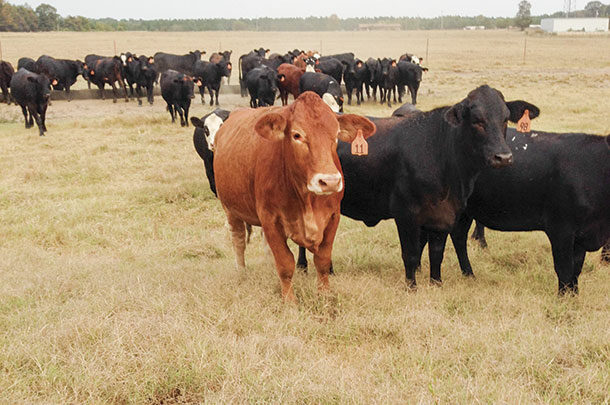When trying to reduce your cost of production, extending the grazing season reduces the costs associated with feeding hay – about 18 to 24 percent of the total cost per calf weaned.
A good rule of thumb is to think one grazing season out so there is a plan well in advance of actually needing the forage. Some ways to extend the grazing season and fill gaps in available forage include: incorporating cool-season annuals, clovers and other legumes; and grazing stockpiled forages.
It’s important to understand stockpiled forage isn’t simply forcing livestock to eat forages they’ve passed over earlier in the grazing season. (They’ve passed over it for a reason.) Rather, stockpiled forages are deliberately accumulated new growth late in the growing season that will be grazed in a managed system during fall and winter.
Grazing stockpiled forages is customizable
John Jennings, a forage specialist at the University of Arkansas, says, “Bermudagrass and tall fescue are most commonly stockpiled forages, but bahiagrass and dallisgrass have also been successfully stockpiled.”
Likewise, Joao Vendramini of the Range Cattle Research and Education Center in Ona, Florida, has successfully demonstrated that limpograss is suitable for stockpiling in south Florida. “It has greater digestibility at extended regrowth intervals when compared to other warm-season grasses.” In research conducted at Ona, limpograss pastures were stockpiled from October to January and grazed from January to March.
Forage availability varies depending on variety, region and management practices. The average date of first frost varies widely from the deep South to the North and is a variable that will affect management practices for stockpiling forages. For example, bermudagrass could be dormant in the northern edge of its productive growing region a full month-and-a-half before it’s dormant in the far southern edge.
The basic steps for stockpiling are:
1. For bermudagrass: In late July or early August, remove standing forage either by cutting for hay or mowing – leaving 2 to 3 inches of stubble. For fescue: Remove standing forage residue in late August or early September – leaving 3 to 4 inches of stubble. For native grasses: Remove livestock from pasture in early July and defer grazing until after a killing frost.
2. Fertilize with 50 to 60 pounds of nitrogen per acre in early to late August. (This may vary depending on your location.) Check with your extension professional to determine application timing best for your forage species and location.
3. Defer grazing of bermudagrass stockpile until late October and fescue until late November to allow for forage accumulation. This may vary depending on the growing conditions in a particular year. Grazing native grass stockpile should be deferred until after a killing frost.
4. For all stockpiled forage species, a system of strip or rotational grazing will minimize forage loss from trampling/defecation and spot grazing.
5. The grazing period will vary by forage species and is highly dependent on the weather. For bermudagrass, the grazing period is typically October to mid-December but can be even longer in more arid places like the southern Great Plains. For fescue, the grazing period is typically November to February. Native grasses hold their quality longer and can be grazed until February in some situations.
Comparing bermudagrass and native grass stockpiles
Dave Lalman, a beef cattle specialist at Oklahoma State University, utilizes both stockpiled bermudagrass and tall grass prairie in winter grazing. His team compared animal performance while grazing stockpiled forages during the fall and winter. In the two-year study, spring-calving beef cows grazed both stockpiles from late October through early February.
The bermudagrass stockpile was established using the standard protocol. Grazing the native grass pastures was deferred from February through October. Cows on the native grass prairie were given 2 pounds daily of a 38 percent crude protein supplement.
The cows on bermudagrass stockpile were allotted fresh forage weekly by moving temporary electric fences and were supplemented 2 pounds of a 25 percent protein feed daily. Weight change and body condition score change didn’t differ between the two groups. The total feed and forage costs per cow for the grazing period were $39.61 for bermudagrass, $42.80 for native grass and $71.88 for an all-hay system.
Stockpiled native grasses
Native grasses are bunch grasses and have more lignin, and usually last longer into the winter from a stockpiling standpoint when compared to introduced forages. The drawback being: They’re typically of lower quality, and therefore producers should sample pastures and supplement accordingly with protein or energy.
Stockpiling native grasses in the southern Great Plains involves removing livestock July 1 and letting it accumulate new growth until a killing frost. This allows a full growing season rest, where it can accumulate forage mass, go to seed and go dormant. At this time, native grasses translocate carbohydrates down the roots and growing point of the crown.
After this process, native grasses can be grazed without causing any damage to the stand. Allowing that deferment period from July through frost allows native grasses to recover from the spring grazing event.
Unlike many stockpiled forages, native grasses don’t require additional fertilizer to accumulate standing forage. James Locke, a soils and crops consultant with the Noble Research Institute, says, “Typically, with native grass, and the type of utilization we get out of it, we don’t recommend fertilization because the economic response is typically not there. We don’t get enough additional grazing to justify the cost of fertilization.”
Like other stockpiled forages, strip grazing native grasses makes utilization much more efficient by preventing waste from livestock and allowing more efficient and consistent utilization across the area.
To maintain a healthy stand, avoid grazing down into the crown and regularly evaluate leaf area. Locke says, “There may appear to be more grazable forage than there really is, so you need to monitor it and adjust accordingly based on the amount of actual forage that is out there.”
The longevity of the stockpile is weather-dependent, but with cool, dry conditions, native grasses can hold their own until February.
Producers wishing to graze native grass pastures can take random grab samples for forage testing in order to determine the supplementation program they’ll need. Supplementing stockpiled native grasses with a 38 to 40 percent crude protein product usually begins at grazing because native grasses are rarely adequate sources of protein due to the plant maturity and lignin content.
Stockpiled fescue
Tall fescue fall growth accounts for up to one-third of the annual dry matter yield. The start date for stockpiling fescue depends on the location but should allow enough time before cold weather to produce acceptable stockpiled forage yield. For example, Jennings says, “In south Arkansas, many fescue pastures are mixed with warm-season grasses.
In that case, stockpiling should begin in late September to early October when growth of the warm-season grass has slowed or stopped to avoid excessive competition with the fescue – but in north Arkansas, we would begin in early September.”
Stockpiled fescue forage is very resistant to freezing temperature, and therefore stockpiled fescue can provide palatable forage through the winter.
Harvest efficiency
Avoid over-grazing and trying to force cattle to use 100 percent of the standing forage. Producers can expect harvest efficiency on stockpiled bermudagrass of 60 to 70 percent; with native grasses, harvest efficiency 50 percent or less, depending on whether a prescribed spring burn is desired in the spring. Jennings says, “The harvest efficiency for stockpiled tall fescue is 70 to 75 percent in a strip-grazing system.”
Lalman also cautions about pushing the harvest efficiency on native grasses: “The more you push them on the harvest efficiency, the closer to the ground they graze it, and the more energy supplementation you may need to help them maintain their body condition.” ![]()
PHOTO: Cows strip grazing stockpiled bermudagrass. Photo by Melissa Beck.

-
Melissa Beck
- Freelance Writer
- Prescott, Arkansas
- Email Melissa Beck










